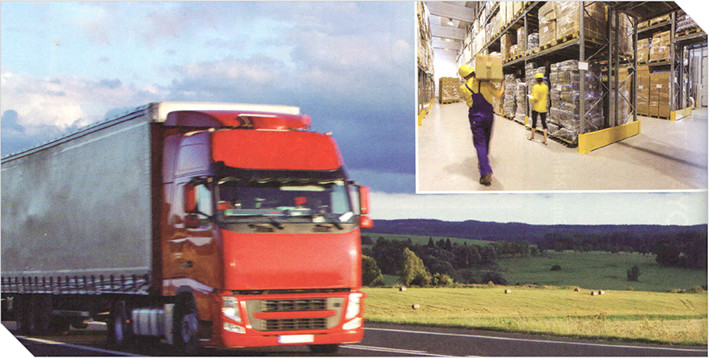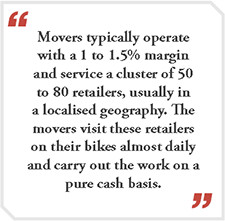Will Movers Become Shakers?
As online and offline retail players compete to drive growth and business, new models and players in logistics have sprung up. Some, like the movers, act as a direct pipe for distributors, wholesalers, retailers, and work according to an on-demand model.
E-commerce companies have faced a challenge that traditional logistics sought to completely avoid. How does one deliver extremely small loads to individual consumers? The holy grail of logistics has always been about scale and utilisation. There is a constant movement towards optimal vehicle choice and full truck loads (FTLs). The need to deliver a single item, say a watch or a book, to an individual customer is completely infeasible in this model. To overcome this problem, the retail industry has started working through a multi-level distribution model going from national warehouse to regional warehouse, to distributor and splitting into different channels thereafter. This has become necessary to ensure full utilisation at each level and minimise unit transportation cost.

E-commerce retailers are making use of the micro-distribution model, employing a combination of very small trucks, like a Tata ACE, and motorcycle delivery the way the courier companies do it. If reports are true, for high value items in the early days of e-commerce, people would even travelled by plane, with the goods to be delivered carried as check-in luggage.
This innovation is driving the boom in e-commerce and ensuring that the customer is served with a high level of service. What about payment? “We will collect cash when we deliver the goods,” is the approach e-commerce players have taken to. Not satisfied with the product? “Don’t accept it and we’ll take it back”. Not satisfied after a few days? “We will come back and collect the item!” Whoever heard of such nonsense until a few years ago? How can anyone make money doing it?
As we all know, no one is really making money doing it. The whole enchilada about e-commerce is to catalyse growth and change customer behaviour. It was about getting a new model of expectations set, which would challenge the status quo, to allow new players to enter the market using very different value propositions.
Traditional logistics gets a new baby cousin
The changes in the delivery model is having an effect on traditional retailers. The newspapers these days are full of the fight on FDI in retail and the different treatment being meted out to online and offline retailers. However, on ground, there are many shifts taking place. These could be in the form of events to drive foot falls to online retailers, or campaigns to “research online, buy offline”. In the process, hybrid models are springing up, which are attempting to blur the line between traditional and online e-commerce retailers. At the same time, e-commerce companies are moving towards pick up and drop off points.
As the two sides seem to move closer together, new ideas are being born. An interesting back-end change that we noticed came up in a research done in the NCR region. There was a new player in the logistics business, the “movers”.
 The movers are an extension of the motorcycle courier delivery model used by the e-commerce retail companies to the field of general trade, the belly of the market. In this area, the movers are providing an independent and entrepreneurial service to help traditional retailers provide higher service levels to their customers by avoiding stock outs. Essentially, they provide fast delivery of small lots to retailers who run out of stock. They act as a direct pipe between the distributors and wholesalers and the retailers in an on demand fashion.</p> <p>Movers typically operate with a 1 to 1.5% margin and service a cluster of 50 to 80 retailers, usually in a localised geography. The movers visit these retailers on their bikes almost daily and carry out the work on a pure cash basis. Distributors are also happy to work with movers. There is no capital investment in vehicles. Movers address pockets of geographies and have a strong entrepreneurial need to ensure increased sale. The fact that it is getting established and growing shows that this seems to be a sustainable model. Essentially, they are arbitraging the poor service levels currently in play in the general trade and ensuring the retailer has a higher availability.</p> <p><strong><
The movers are an extension of the motorcycle courier delivery model used by the e-commerce retail companies to the field of general trade, the belly of the market. In this area, the movers are providing an independent and entrepreneurial service to help traditional retailers provide higher service levels to their customers by avoiding stock outs. Essentially, they provide fast delivery of small lots to retailers who run out of stock. They act as a direct pipe between the distributors and wholesalers and the retailers in an on demand fashion.</p> <p>Movers typically operate with a 1 to 1.5% margin and service a cluster of 50 to 80 retailers, usually in a localised geography. The movers visit these retailers on their bikes almost daily and carry out the work on a pure cash basis. Distributors are also happy to work with movers. There is no capital investment in vehicles. Movers address pockets of geographies and have a strong entrepreneurial need to ensure increased sale. The fact that it is getting established and growing shows that this seems to be a sustainable model. Essentially, they are arbitraging the poor service levels currently in play in the general trade and ensuring the retailer has a higher availability.</p> <p><strong>< Is this the way of the future?
Is this the way of the future?
Will distribution models in retail lean increasingly towards movers? Are traditional models of distribution outdated and do they need to be scrapped? While all this sounds quite dramatic, it is highly unlikely. Firstly, the markets in India still need an extreme cost focus to maintain price points. Secondly, the sheer volumes of goods cannot be transported on motorcycles. And, thirdly, the ability to bring enhancements through any form of technology will be difficult if there are thousands of independent delivery people in a market.
So what is likely to happen? Retailers are likely to continue to work with movers, but can only leverage them to meet shortages for specific needs – meeting the requirement of a valued customer, ensuring a reputation of consistent availability or stocking items that sell is very small volumes eliminating the need for the retailer to send someone to a wholesaler.
Evolution can also take place. Movers are likely to get aggregated using mobile technology, just as taxi services have been. Some may move up the volume scale and get a small fleet of motorcycles or mixed vehicles, becoming specialist local distributors. Given the congestion and traffic density of many Indian markets, it may make sense for localised delivery agencies to take over small crowded areas.
Finally, they may be harnessed by manufacturers directly in select cases. HUL has online sale of Aviance, Ayush and Lever Home products. Specific markets could potentially be linked with such movers for delivery to homes and pick up points.
What is clear though is that movers are exploiting a weakness in the traditional distribution model. The result is a better service level of customers. So, this could be the starting point for further change in distribution and delivery models. Movers still have the potential to shake things up.
The author is Partner & Managing Director – Indian Operations, CGN & Associates India Pvt Ltd




.png?width=203&name=CGN_Tagline1%20(1).png)